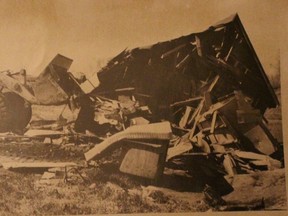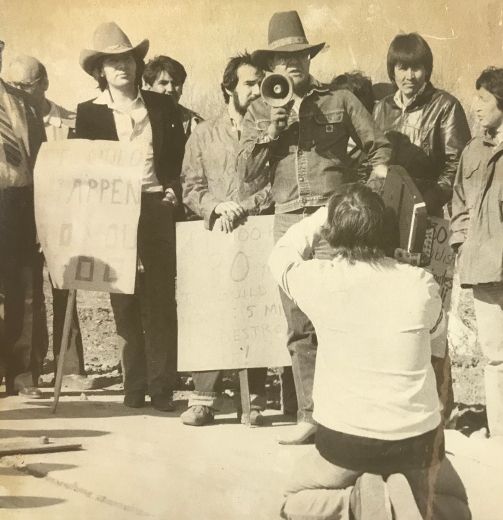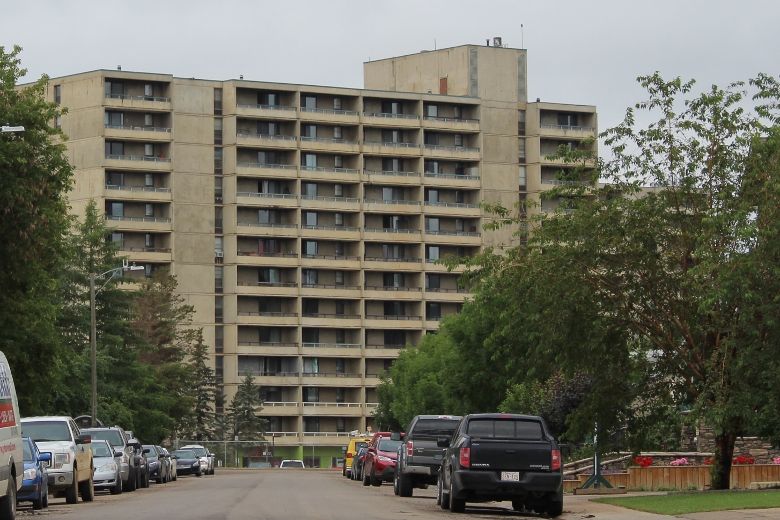McMurray Métis reviewing past city-led evictions of Indigenous settlement

Article content
Fort McMurray Métis Local 1935 is launching a review into a painful chapter of their history in the late 1970s and early 1980s, and are looking for anyone who may still have memories of what happened.
The investigation will examine the destruction of Moccasin Flats, a community of makeshift homes that once lined the Snye. Until 1981, the spot was a settlement for Métis, Cree and Dene families in the warmer months after spending winter on traplines.
In the 1970s, Fort McMurray began expanding and, much like the following oil booms, local leaders found themselves desperate for space.
City officials - Fort McMurray would not amalgamate into a regional municipality until 1995 - began expropriating land throughout the mid-1970s.
The spot was eyed by the city government for a bypass and sewage line. The land also became the site of the River Park Glen apartments.

People protest the eviction of Indigenous families at the Snye in this Today file photo from May 15, 1981.
Copies of the Fort McMurray Today from that period show the dispute between the residents of Moccasin Flats and city officials lasted as long as six years.
The residents of Moccasin Flats were referred to as "squatters" living in a "shanty-town community" by city officials, local residents and this newspaper.
Many residents accepted offers to resettle elsewhere. Bill Loutitt, CEO of McMurray Métis, says many of these new homes were “lower quality housing.”
The Today also reported that workers would throw tools, garbage and concrete chunks at people living below. The people were also verbally taunted and insulted by workers and bystanders.
"They have been subjected to disgraceful bullying," said Stan Daniels, president of the Métis Association of Alberta, in the March 31, 1977 edition of the Today. "Authorities hope the natives will move away quietly. But there has been a native community on the banks of the river as long as there have been people in this area."

A sign left at the former site of houses near the Snye in this Today file photo from May 20, 1981. The sign is addressed to Ted Mason, who was mayor of the City of Fort McMurray between 1977 and 1983.
In 1981, there were only a handful of families still in the area. On May 15, 1981, the Today reported the few families who refused to go anywhere were told by police they were being evicted. Their homes were bulldozed shortly after.
“They just came in, didn’t knock or anything, told us to get dressed and leave,” said a 17-year-old Russell Shott to the Today. “Mother wasn’t dressed or anything, she was still lying in bed asleep.”
Shott's father, Patrick, was working at Suncor when he was told what was happening. He rushed home to find police and city workers taking his personal belongings out of the home. He he had lived on the spot for 25 years and that the home was 20 years old.
A fight broke out and he was arrested. A judge said he sympathized with how Shott must have felt, but found him guilty of assaulting a bylaw worker. Shott was fined $100.
City officials told the Today the family was living on land zoned as a municipal road allowance. They had been given a 48-hour notice to leave three weeks prior.
“This was the first time we’ve ever had to go to such an extreme to move somebody,” said Jerry Bussieres, city clerk of the day in an interview with the Today published May 20, 1981. “But you never can tell what the future will bring. It’s unfortunate when it has to happen that way.”

Part of the River Glen Park apartment complex, commonly known as the Syncrude Towers, as seen from the corner of Fraser Avenue and Morrison Street in downtown Fort McMurray, Alta. on Tuesday July 21, 2015. Vincent McDermott/Fort McMurray Today/Postmedia Network
In a Jan. 2017 story, McMurray Métis president Gail Gallupe called the apartments now standing over downtown "grisly tomb stones over a once vibrant community."
“To build the Syncrude Towers, the Town of Fort McMurray and the Government of Alberta redefined the Métis space of Moccasin Flats as Crown Land and town property. Labelling the Métis families who lived there as ‘squatters,’” said Loutitt in a statement. “The long term social, economic and cultural impacts haven’t been fully examined until now.”
The research will be conducted by Tara Joly, an anthropology researcher and instructor, and Hereward Longley, a PhD candidate in Environmental History at the University of Alberta. The two have a combined 10 years of experience working with McMurray Métis.
Gallupe is asking anyone who was affected or their family to contact Local 1935.
“Our goal at the end of this five-month fact-finding mission is to help the local Métis communities heal from this horrible injustice,” she said.
vmcdermott@postmedia.com